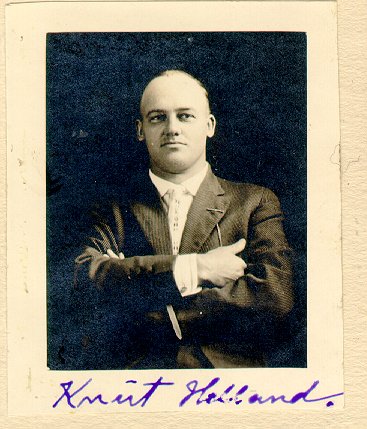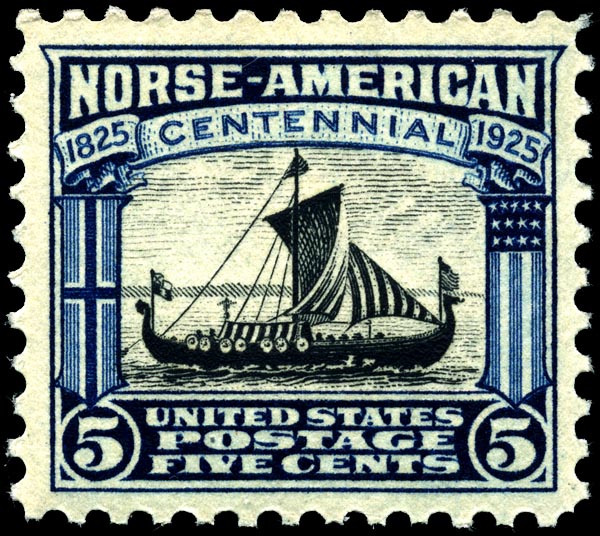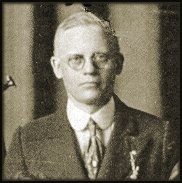|
Knut Gunnarsson Helland
Knut Gunnarsson Helland (November 6, 1880–June 27, 1919) was a Norwegian American Hardanger fiddle maker. Biography Knut Gunnarson Helland was from Bø, Norway. Helland worked in the traditional region of Telemark in the workshop of his father, Gunnar Olavsson Helland, until he emigrated to United States in 1901. In 1905, he started Helland Brothers workshop in Chippewa Falls, Wisconsin, with his brother Gunnar Gunnarsson Helland. Knut Helland died in 1919, three weeks after surgery for appendicitis. His brother, Gunnar continued the workshop alone until it was closed down in 1927. Hardanger fiddle Image:FeleHel (2).jpg, --> Image:Bunn.jpg, Lower part of body with tailpiece Image:Midt.jpg, Central part of body Image:Midtdetalj.jpg, Central part of body, detail Image:Gripebrett.jpg, Gripboard Image:Sarg.jpg, Frame, rosepainting Image:Topp.jpg, Head See also * The Helland fiddle maker family The Helland family from Bø in Telemark is a Norwegian dynasty of Hardanger fi ... [...More Info...] [...Related Items...] OR: [Wikipedia] [Google] [Baidu] |
Norwegian American
Norwegian Americans ( nb, Norskamerikanere, nn, Norskamerikanarar) are Americans with ancestral roots in Norway. Norwegian immigrants went to the United States primarily in the latter half of the 19th century and the first few decades of the 20th century. There are more than 4.5 million Norwegian Americans, according to the 2021 U.S. census,; most live in the Upper Midwest and on the West Coast of the United States. Immigration Viking-era exploration Norsemen from Greenland and Iceland were the first Europeans to reach North America. Leif Erikson reached North America via Norse settlements in Greenland around the year 1000. Norse settlers from Greenland founded the settlement of L'Anse aux Meadows and Point Rosee in Vinland, in what is now Newfoundland, Canada. These settlers failed to establish a permanent settlement because of conflicts with indigenous people and within the Norse community. Colonial settlement The Netherlands, and especially the cities of Amsterdam and ... [...More Info...] [...Related Items...] OR: [Wikipedia] [Google] [Baidu] |
Hardanger Fiddle
A Hardanger fiddle ( no, hardingfele) is a traditional stringed instrument considered to be the national instrument of Norway. In modern designs, this type of fiddle is very similar to the violin, though with eight or nine strings (rather than four as on a standard violin) and thinner wood. The F-holes of the Hardanger fiddle are unique, oftentimes with a more “sunken” appearance, and generally straighter edges (unlike the frilly, swirly F-holes of a violin). Four of the strings are strung and played like a violin, while the rest, named understrings or sympathetic strings, resonate under the influence of the other four. These extra strings are tuned and secured with extra pegs at the top of the scroll, effectively doubling the length of a Hardingfele scroll when compared to a violin. The sympathetic strings, once fastened to their pegs, are funneled through a “hollow” constructed fingerboard, which is built differently than a violin’s, being slightly higher and thicker to ... [...More Info...] [...Related Items...] OR: [Wikipedia] [Google] [Baidu] |
Bø, Telemark
Bø is a village and municipality in Telemark county, Norway. It is part of the traditional region of Midt-Telemark, but was historically regarded as part of Grenland. The administrative centre of the municipality is the village of Bø i Telemark ("Bø in Telemark"). Bø has been a settlement since ancient times, a parish since the middle ages and became a municipality (''formannskapsdistrikt'') in 1838. The area of Lunde was separated from Bø in 1867 to become a separate municipality. Bø has a population of 5,977 (2015). Bø's economy is mainly based on agriculture, forestry, tourism, education and public administration. Bø has the character of a university town and is home to one of the principal campuses of the University of Southeast Norway; it was also the seat of one of the university's three predecessor institutions, Telemark University College. Bø is well known for its cultural traditions within traditional music and artisanship, and its central position within Norwe ... [...More Info...] [...Related Items...] OR: [Wikipedia] [Google] [Baidu] |
Norway
Norway, officially the Kingdom of Norway, is a Nordic country in Northern Europe, the mainland territory of which comprises the western and northernmost portion of the Scandinavian Peninsula. The remote Arctic island of Jan Mayen and the archipelago of Svalbard also form part of Norway. Bouvet Island, located in the Subantarctic, is a dependency of Norway; it also lays claims to the Antarctic territories of Peter I Island and Queen Maud Land. The capital and largest city in Norway is Oslo. Norway has a total area of and had a population of 5,425,270 in January 2022. The country shares a long eastern border with Sweden at a length of . It is bordered by Finland and Russia to the northeast and the Skagerrak strait to the south, on the other side of which are Denmark and the United Kingdom. Norway has an extensive coastline, facing the North Atlantic Ocean and the Barents Sea. The maritime influence dominates Norway's climate, with mild lowland temperatures on the se ... [...More Info...] [...Related Items...] OR: [Wikipedia] [Google] [Baidu] |
Telemark
Telemark is a traditional region, a former county, and a current electoral district in southern Norway. In 2020, Telemark merged with the former county of Vestfold to form the county of Vestfold og Telemark. Telemark borders the traditional regions and former counties of Vestfold, Buskerud, Hordaland, Rogaland and Aust-Agder. The name ''Telemark'' means the "mark of the Thelir", the ancient North Germanic tribe that inhabited what is now known as Upper Telemark in the Migration Period and the Viking Age. In the Middle Ages, the agricultural society of Upper Telemark was considered the most violent region of Norway. Today, half of the buildings from medieval times in Norway are located here. The dialects spoken in Upper Telemark also retain more elements of Old Norse than those spoken elsewhere in the country. Upper Telemark is also known as the birthplace of skiing. The southern part of Telemark, Grenland, is more urban and influenced by trade with the Low Countries, no ... [...More Info...] [...Related Items...] OR: [Wikipedia] [Google] [Baidu] |
Gunnar Olavsson Helland
Gunnar Olavsson Helland (July 15, 1852 – 1938) was a Norwegian Hardanger fiddle (''hardingfele'') maker from Bø, Telemark, Bø in Telemark, Norway. Biography Gunnar Olavsson Haugen was a brother-in-law of Knut Eriksson Helland who was married to his sister, Liv Olavsdatter Haugen (1849-1883). In 1871, Gunnar Haugen married the twin sister of Knut Helland, Gunnhild Eriksdatter Helland (1851–1907). Gunnar and Gunnhild were the parents of: *Olav Gunnarsson Helland (1875–1946) *Knut Gunnarsson Helland (1880–1920) *Gunnar Gunnarsson Helland (1889–1976) *John Gunnarsson Helland (1897–1977) Following his marriage to Gunnhild, Gunnar Olavsson Haugen re-located to Helland and shortly after began learning the art of making violins from his brother-in-law. He became a successful violin maker, winning prizes and medals both in Norway and abroad. When Knut Helland died in 1880, Gunnar took over both the family farm and the fiddle workshop, at which time he adopted the surna ... [...More Info...] [...Related Items...] OR: [Wikipedia] [Google] [Baidu] |
Chippewa Falls, Wisconsin
Chippewa Falls is a city located on the Chippewa River in Chippewa County in the northwestern part of the U.S. state of Wisconsin. The population was 14,778 in the 2021 census. Incorporated as a city in 1869, it is the county seat of Chippewa County. The city's name originated from its location on the Chippewa River, which is named after the Ojibwe Native Americans. ''Chippewa'' is an alternative rendition of ''Ojibwe.'' Chippewa Falls is the birthplace of Seymour Cray, known as the "father of supercomputing", and the headquarters for the original Cray Research. It is also the home of the Jacob Leinenkugel Brewing Company, the Heyde Center for the Arts, a showcase venue for artists and performers; Irvine Park, and the annual Northern Wisconsin State Fair. Chippewa Falls is from the annual four-day music festivals Country Fest and Rock Fest. History For thousands of years the Chippewa River was a water highway through a wilderness of forests and swamps, travelled by Ojibwe ... [...More Info...] [...Related Items...] OR: [Wikipedia] [Google] [Baidu] |
Wisconsin
Wisconsin () is a state in the upper Midwestern United States. Wisconsin is the 25th-largest state by total area and the 20th-most populous. It is bordered by Minnesota to the west, Iowa to the southwest, Illinois to the south, Lake Michigan to the east, Michigan to the northeast, and Lake Superior to the north. The bulk of Wisconsin's population live in areas situated along the shores of Lake Michigan. The largest city, Milwaukee, anchors its largest metropolitan area, followed by Green Bay and Kenosha, the third- and fourth-most-populated Wisconsin cities respectively. The state capital, Madison, is currently the second-most-populated and fastest-growing city in the state. Wisconsin is divided into 72 counties and as of the 2020 census had a population of nearly 5.9 million. Wisconsin's geography is diverse, having been greatly impacted by glaciers during the Ice Age with the exception of the Driftless Area. The Northern Highland and Western Upland along wi ... [...More Info...] [...Related Items...] OR: [Wikipedia] [Google] [Baidu] |
Gunnar Gunnarsson Helland
Gunnar Gunnarsson Helland (January 26, 1885 – April 20, 1976) was a Norwegian-American Hardanger fiddle maker. Background Gunnar Gunnarsson Helland was a member of the Helland fiddle maker family of Bø, Norway. Helland worked in the traditional region of Telemark in the workshop of his father, Gunnar Olavsson Helland, until he emigrated to United States in 1901 and settled in Chippewa Falls, Wisconsin. He had three children: Alton, Edith, and Gilman, with his wife, Edith. Career Together with his brother Knut Gunnarsson Helland, he started the Helland Brothers workshop in 1905. His brother died in 1920 and Gunnar Helland ran Helland Brothers alone until he closed down in 1927, at a time when the demand for violins was in decline. In 1927, Gunnar Helland moved to Minneapolis and spent two years working at Lundh & Rowe for Jacob Lundh (1865-1951) and Frederick Rowe (1884-1976). In 1929, he moved to Fargo, North Dakota where he established the Helland Music C ... [...More Info...] [...Related Items...] OR: [Wikipedia] [Google] [Baidu] |
The Helland Fiddle Maker Family
The Helland family from Bø in Telemark is a Norwegian dynasty of Hardanger fiddle makers who made the most significant and important contribution to the development of the Norwegian Hardanger fiddle tradition. The celebrated Norwegian fiddler Ole Bull played on Helland fiddles. During nearly 200 years and four generations the family counted 14 fiddle makers, many of them among the most important in the fiddle-maker tradition in Norway. It may well be the largest fiddle maker family in history. From Bø in Telemark to Notodden, Skien and Wisconsin Olav Gunnarson Helland settled in Notodden, Telemark, Norway in 1896 and established a Hardanger fiddle workshop. His fiddles are considered among the finest within the tradition. Knut Gunnarsson Helland and Gunnar Gunnarsson Helland emigrated to US in 1901 and settled in Chippewa Falls, Wisconsin where they became well known ski jumpers. They opened a fiddle workshop, " Helland Brothers" together. Knut died in 1920 and his brother G ... [...More Info...] [...Related Items...] OR: [Wikipedia] [Google] [Baidu] |
1880 Births
Year 188 (CLXXXVIII) was a leap year starting on Monday of the Julian calendar. At the time, it was known in the Roman Empire as the Year of the Consulship of Fuscianus and Silanus (or, less frequently, year 941 ''Ab urbe condita''). The denomination 188 for this year has been used since the early medieval period, when the Anno Domini calendar era became the prevalent method in Europe for naming years. Events By place Roman Empire * Publius Helvius Pertinax becomes pro-consul of Africa from 188 to 189. Japan * Queen Himiko (or Shingi Waō) begins her reign in Japan (until 248). Births * April 4 – Caracalla (or Antoninus), Roman emperor (d. 217) * Lu Ji (or Gongji), Chinese official and politician (d. 219) * Sun Shao, Chinese general of the Eastern Wu state (d. 241) Deaths * March 17 – Julian, pope and patriarch of Alexandria * Fa Zhen (or Gaoqing), Chinese scholar (b. AD 100) * Lucius Antistius Burrus, Roman politician (executed) * Ma Xiang, Chin ... [...More Info...] [...Related Items...] OR: [Wikipedia] [Google] [Baidu] |







